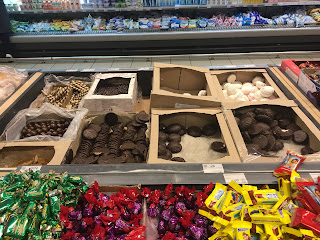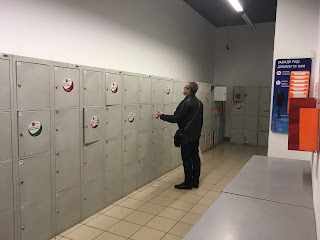And now, for the finale - we're going thrifting!
(I definitely just took 5 mins away from writing this so I could rock out to Macklemore. Content note - this video has hella cuss words)
There are thrift shops EVERYWHERE in my city, and the holiday season's festivities have afforded me an excellent occasion to check them out: tomorrow I'm bound for a 1920's speakeasy-themed swing dancing party in Kyiv for New Year's. Time to pop some tags (figuratively... clothes in thrift shops here don't have price tags. Read on to find out).
From the time I left the landing of my apartment, it took me exactly 2 minutes and 56 seconds to walk to the nearest thrift shop (including the 6 flights of stairs I had to descend to leave my building).
The name of this shop: Planet Second Hand. The phrase "second hand" is not actually translated into Ukrainian; people use an approximation of the English phrase, written in Cyrillic characters. Go ahead and try saying "second hand" to yourself right now in a really strong Ukrainian accent. Give it a go. Now you know how to say "second hand" in Ukrainian :-P
This particular shop was small and mostly full of sad, musty things. I took one turn around the shop and then journeyed 8 minutes and 47 seconds on to the next one. I was twice almost run over by cars blowing through the crosswalks, because that's just how people drive here.
 |
| What's better than thrifting? Coffee and thrifting! This coffee-mobile is almost always parked out here. |
Euro Second-Hand is probably the most common thrift chain I have seen in my city, and it does tend to be decent. In Ukraine, "Euro-" is often used as a descriptor or prefix to mean "good" or "the best". For example, it is common to see the phrase "Euro-remont" (Euro-renovation) to describe nicely renovated apartments. So, European second-hand stuff is ostensibly the best second-hand stuff.
Now for an interesting tidbit about thrifting in Ukraine: note the words below the shop name on the sign above. "Одяг на вагу" (odyah na vahy) means "clothing by weight". Second-hand clothes are sold by the kilogram! Hence, no price tags to pop. Instead, there is a scale at the register, and they weigh whatever mound of stuff you have managed to rummage up.
Euro Second-Hand did not yield my needed 1920's dress, but as things tend to go when thrifting, I found a dress I absolutely wasn't looking for, and decided I must have it.
 |
| This lucky find cost 22 hryvnia, or slightly less than a dollar. |
See where the red signage turns to yellow signage? That marks the boundary between the two thrift shops that share this building.
Another thing to know about thrifting in Ukraine: each store has its own inventory day. That's the day when they receive a new shipment of clothing.
This shop gets in new clothes щоп'ятниці - every Friday - and wants to make sure you are aware of the fact!
On the sign below, from yet another thrift shop, you can see that the inventory day is Четвер (Chetver) - Thursday. On the morning of inventory day, it is not uncommon to see a crowd of people gathered at the doors of the shop, waiting for it to open.
The per-kilogram price for clothing is highest on inventory day, because that's when all the good stuff is in stock. As everything gets picked over, the price drops. For example, in this shop, clothes cost 215 hryvnia per kilo on Thursday, 182 on Friday, and by the time the next Wednesday rolls around and only the stuff that nobody wants is left over, the price has plummeted to 19 hryvnia per kilo. Some shops also sort out the highest-quality items and put them on a "luxe" rack, which follows the same pricing system but at a higher cost.
My strategy when thrifting is usually to go a day or two after inventory day, so that I am not jostled and elbowed about by a crowd of eager shoppers, but can still get some good items before everything is bought up. Anyway, my third thrift shop of the hour still did not yield my sought-after 1920s dress, so I carried on to the next, which would have been 2 minutes and 17 seconds away had it not recently relocated.
 |
| Yes, another Euro Second-Hand. This old location is about 2 minutes away from the first Euro Second-Hand, while the new location is maybe 3 minutes away. |
It is not unusual for thrift shops to be located on the second floor of whatever building they are in. To get to this one, I had to walk through a cell phone store and follow the many signs informing me to take the stairs to the second-hand shop. The former location of this shop was similarly situated, although with an outdoor staircase that bypassed the need to walk through whatever other shop the thrift shop is on top of.
Thrift shop number four had some promising dresses that came close to what I was looking for, but not quite. I instead bought yet another dress I wasn't looking for, at a price 34 hryvnia, or about the cost of a latte. 1 hour, four shops, and two unintentional purchases in, I decided that that was enough thrifting for today, and I eventually found the sort of dress I was looking for at the mall. So, thrifting fail today - but I know Macklemore is on to something, because most of the compliments I get from locals about my clothes are on things I got at a local thrift shop. And next time the thrifting bug strikes, there are still at least half-a-dozen little thrift shops I have yet to check out.
(as usual... this blog reflects my views only, and is not indicative of the views or policies of Peace Corps, the US, or Ukraine).






























